Abstract
The effect of temperature on the production of F pili by an F+ strain of Escherichia coli B/r was studied by electron microscopy and by a technique involving serum-blocking power. The latter method is based on the ability of F pili to adsorb F pili antibody which inhibits male-specific phage infection. The total amount of pili in a sample was estimated by serum-blocking power; the length of F pili and number per cell was determined by electron microscopy. Cell extracts prepared by sonic oscillation lacked serum-blocking power, suggesting that F pili are not present in the cytoplasm. The number of F pili per cell varied with the growth temperature, but the average length of F pili remained constant. Maximum number of pili per cell occurs between 37 and 42 C; below 37 C the number decreases, reaching zero at about 25 C. When cells are grown at 37 C, blended, and resuspended in fresh media at 25 C, they make F pili. These pili are probably assembled from a pool of subunits that were synthesized during growth at 37 C. The rates of assembly at 25 and 37 C, as judged by the rate of increase in length of F pili, are similar. When cells were grown at 25 C and shifted up to 37 C, there was a 30-min lag in pili production followed by a period of rapid outgrowth. When cells were shifted down from 37 to 20 C, outgrowth (assembly) of pili ceased, and approximately 50% of the attached pili were released in 2 min. No release was observed when cells were shifted to 0 C. This suggests that pili may be released from the cell by a mechanism that requires metabolic activity, but not the outgrowth of F pili.
Full text
PDF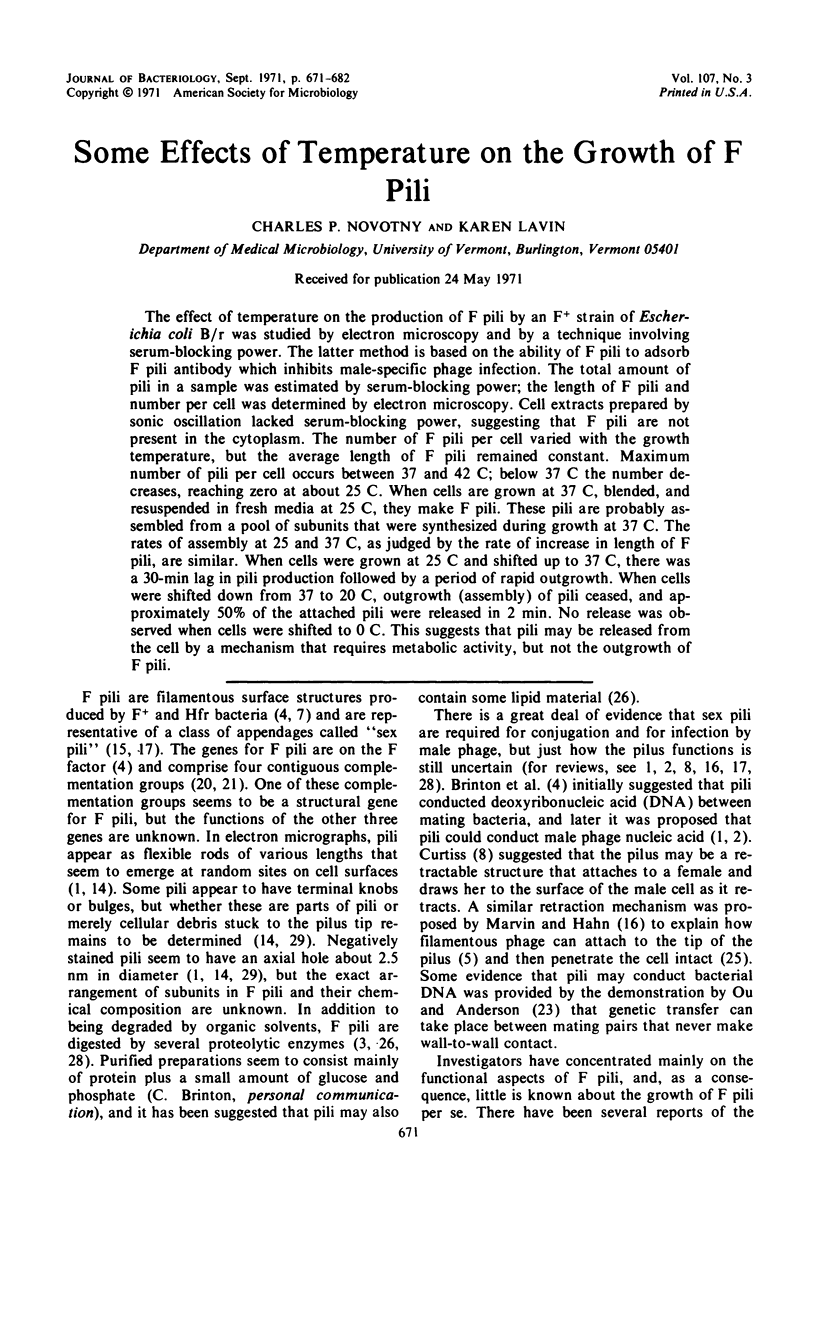
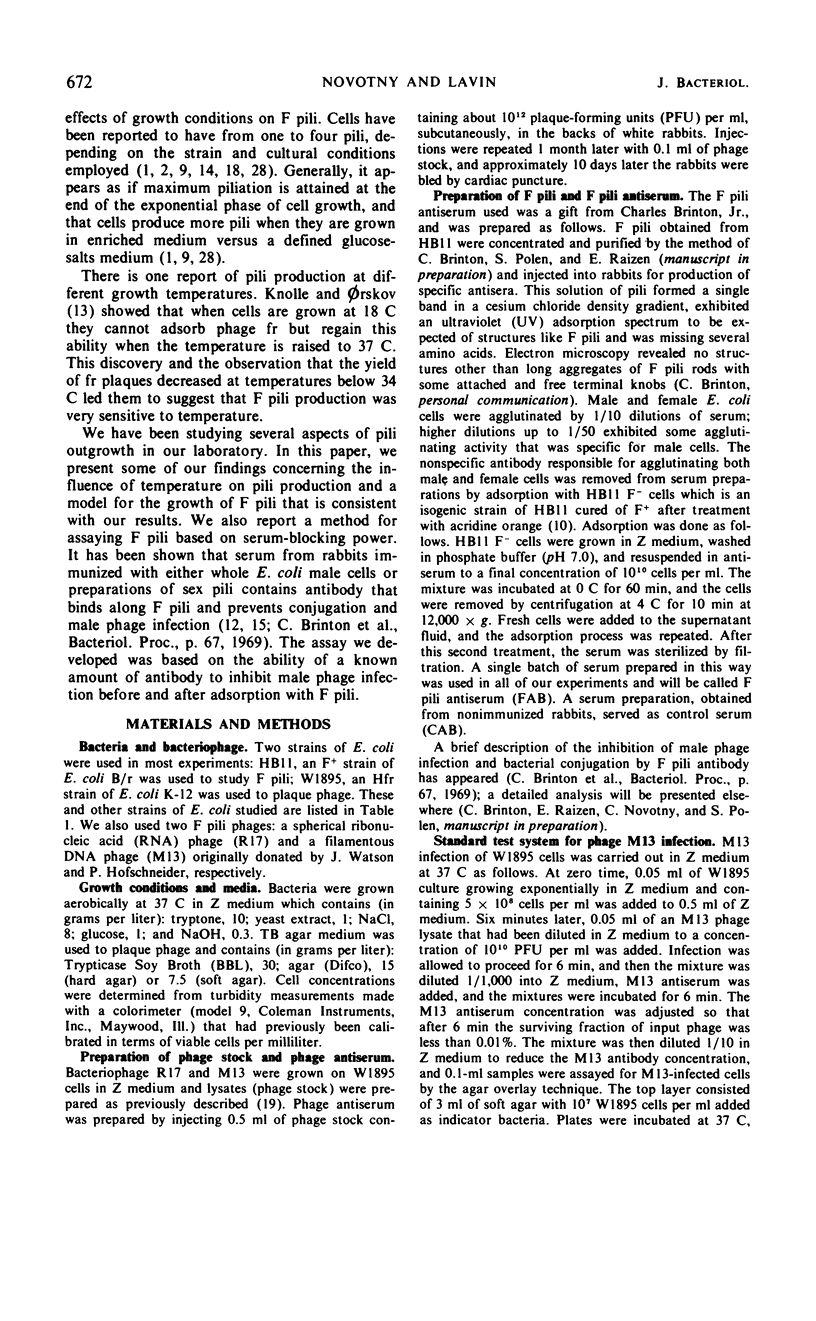
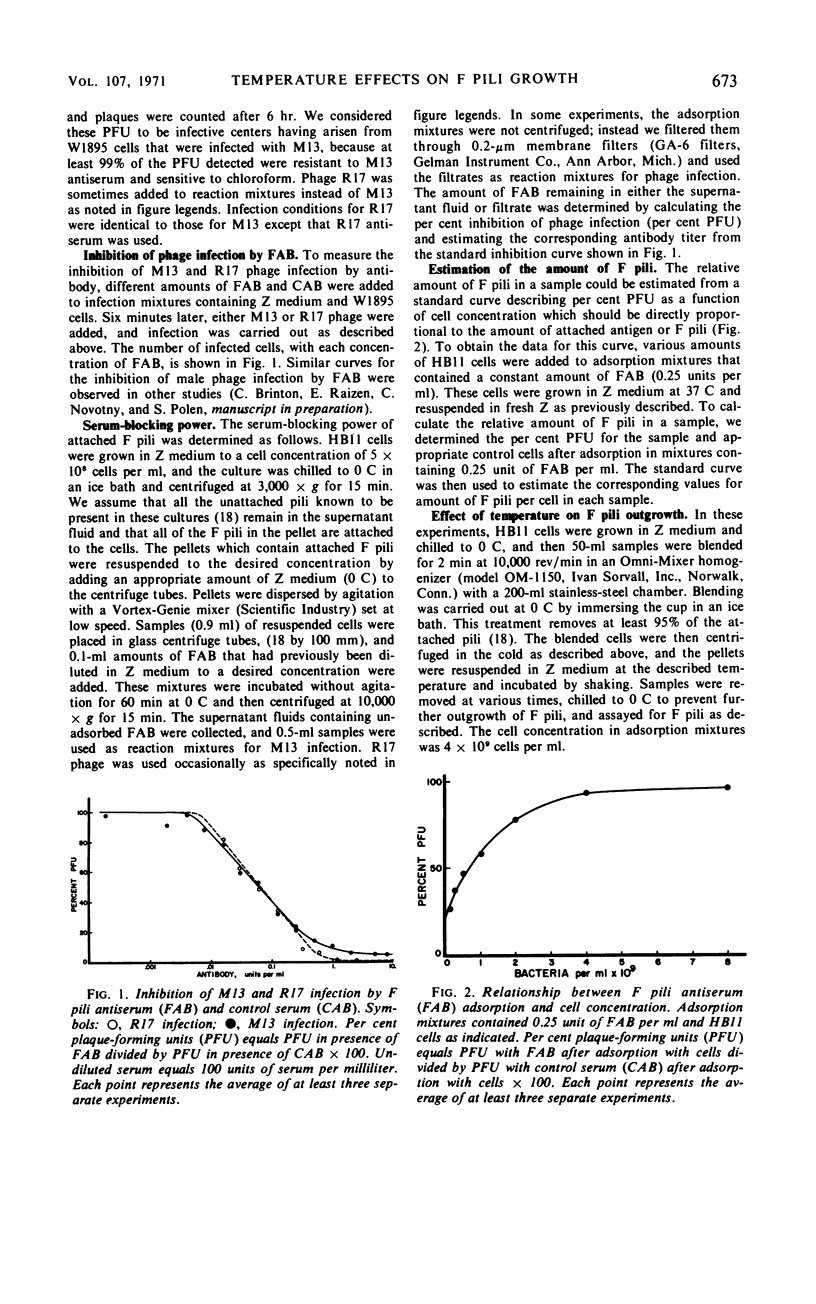
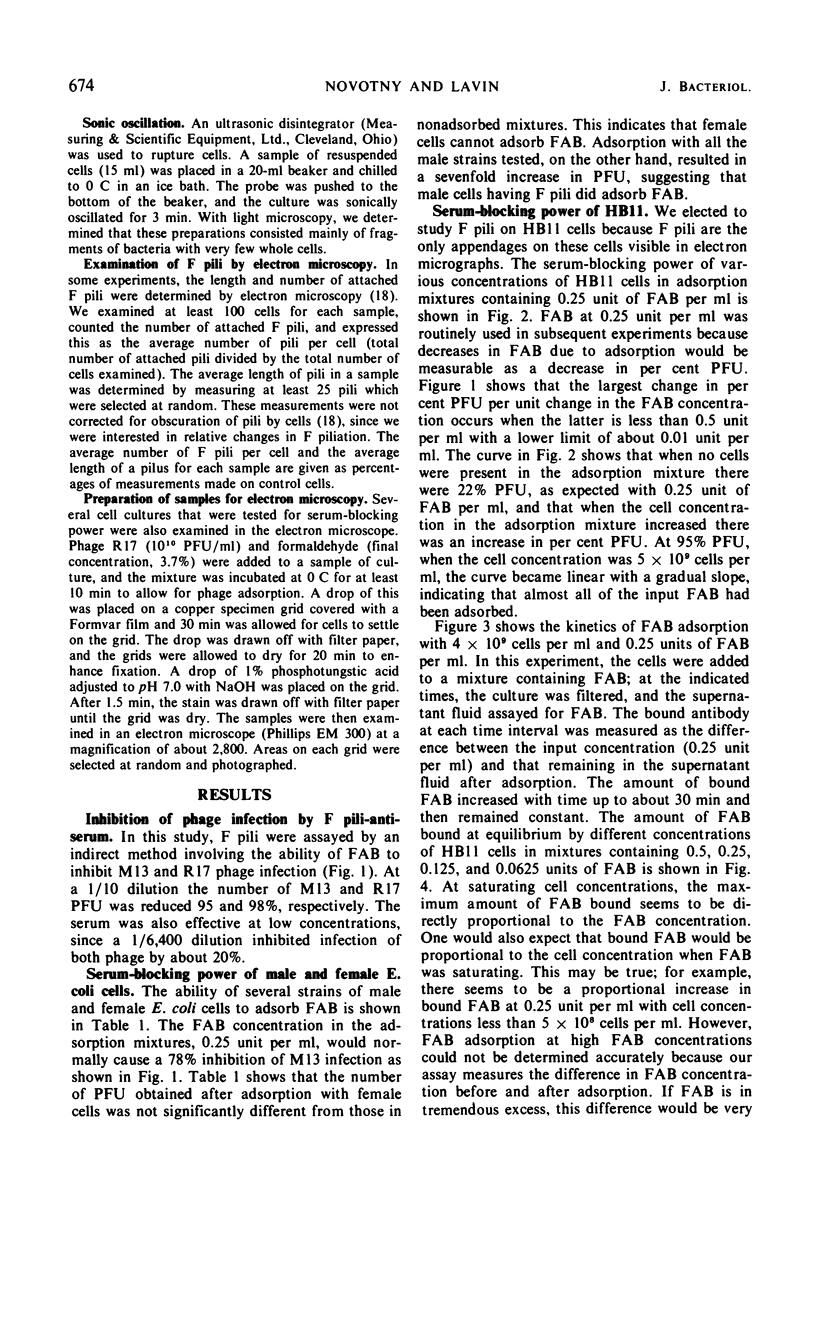
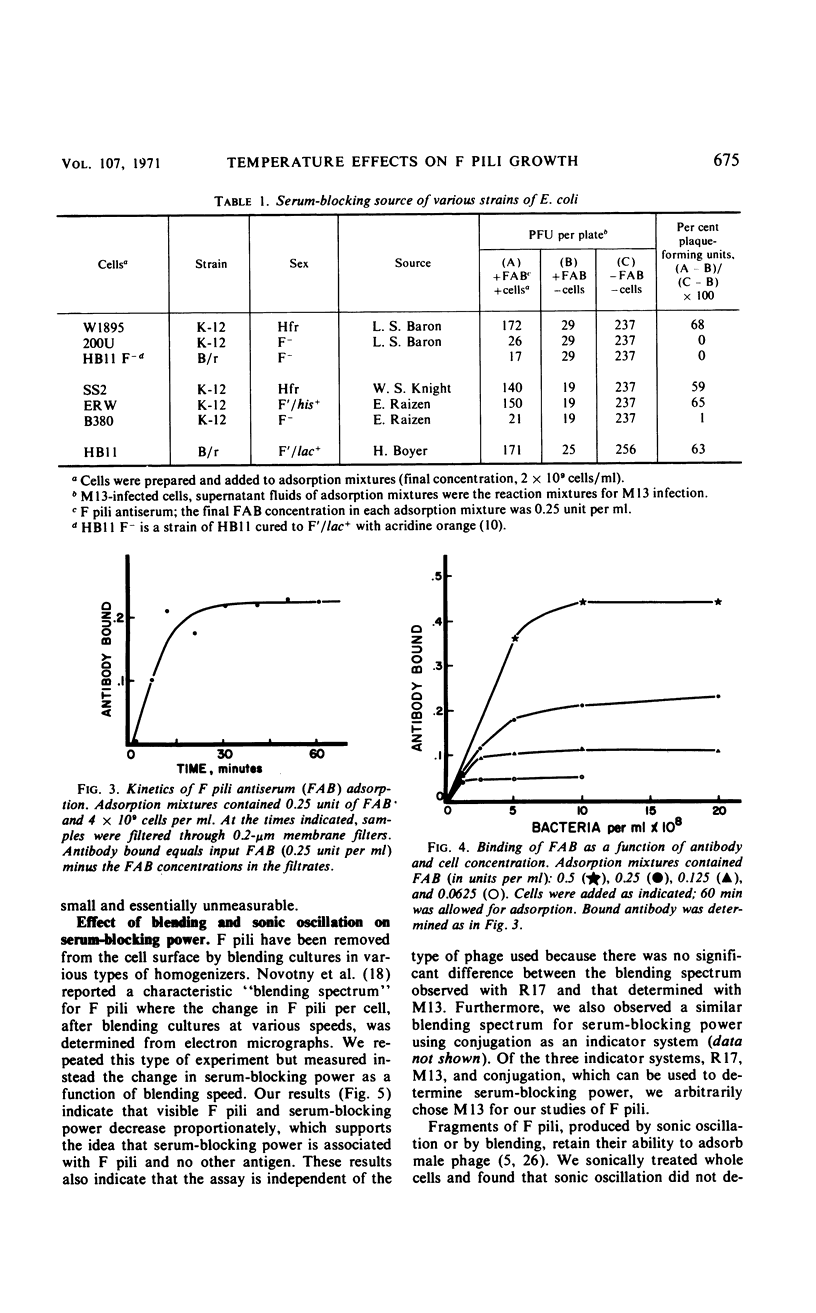
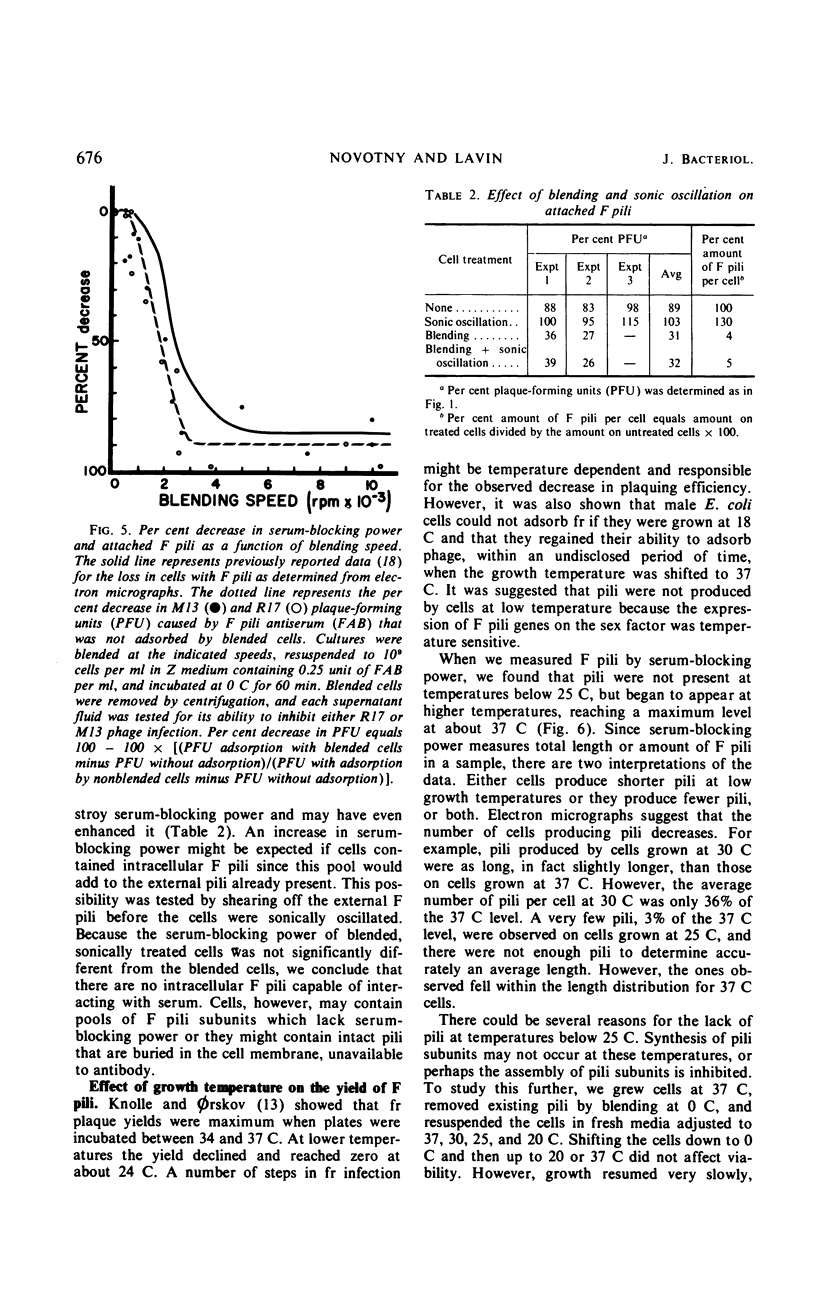
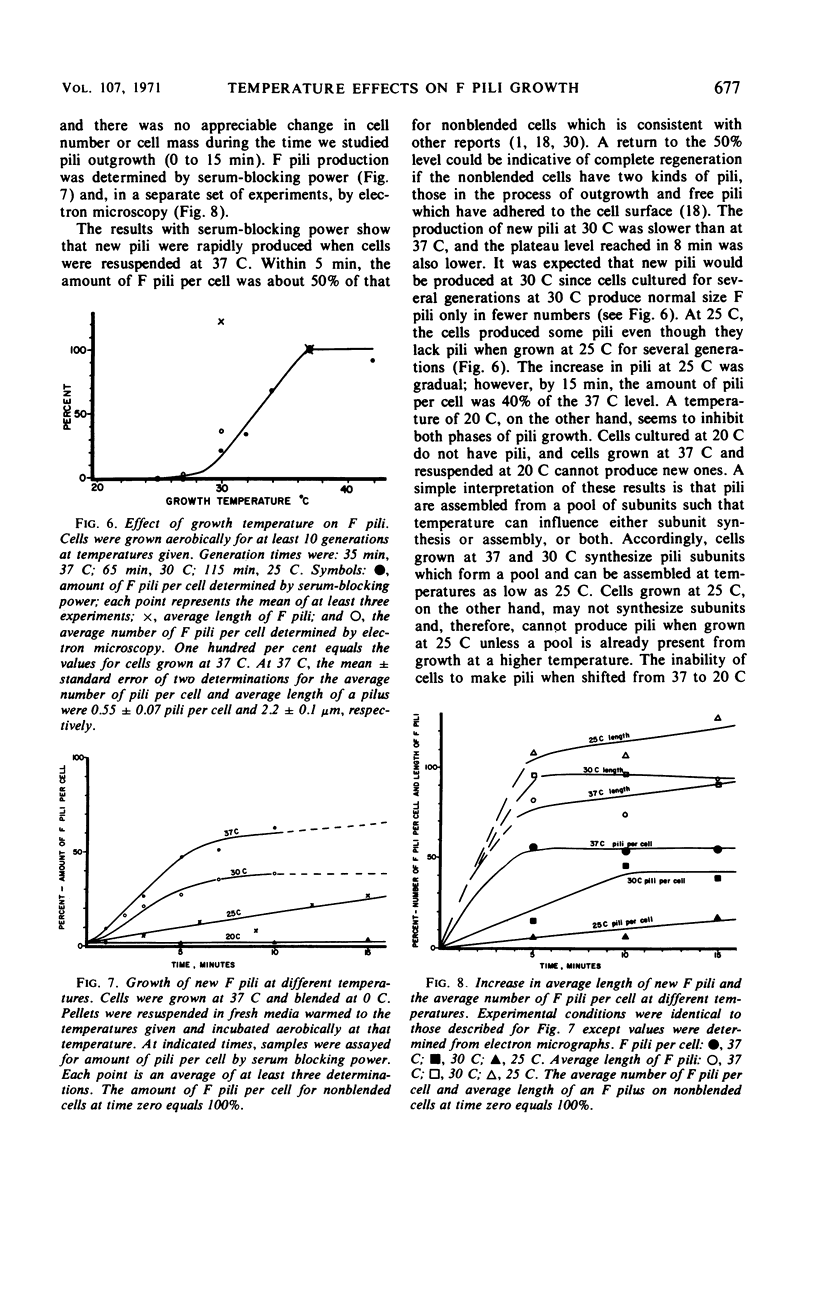
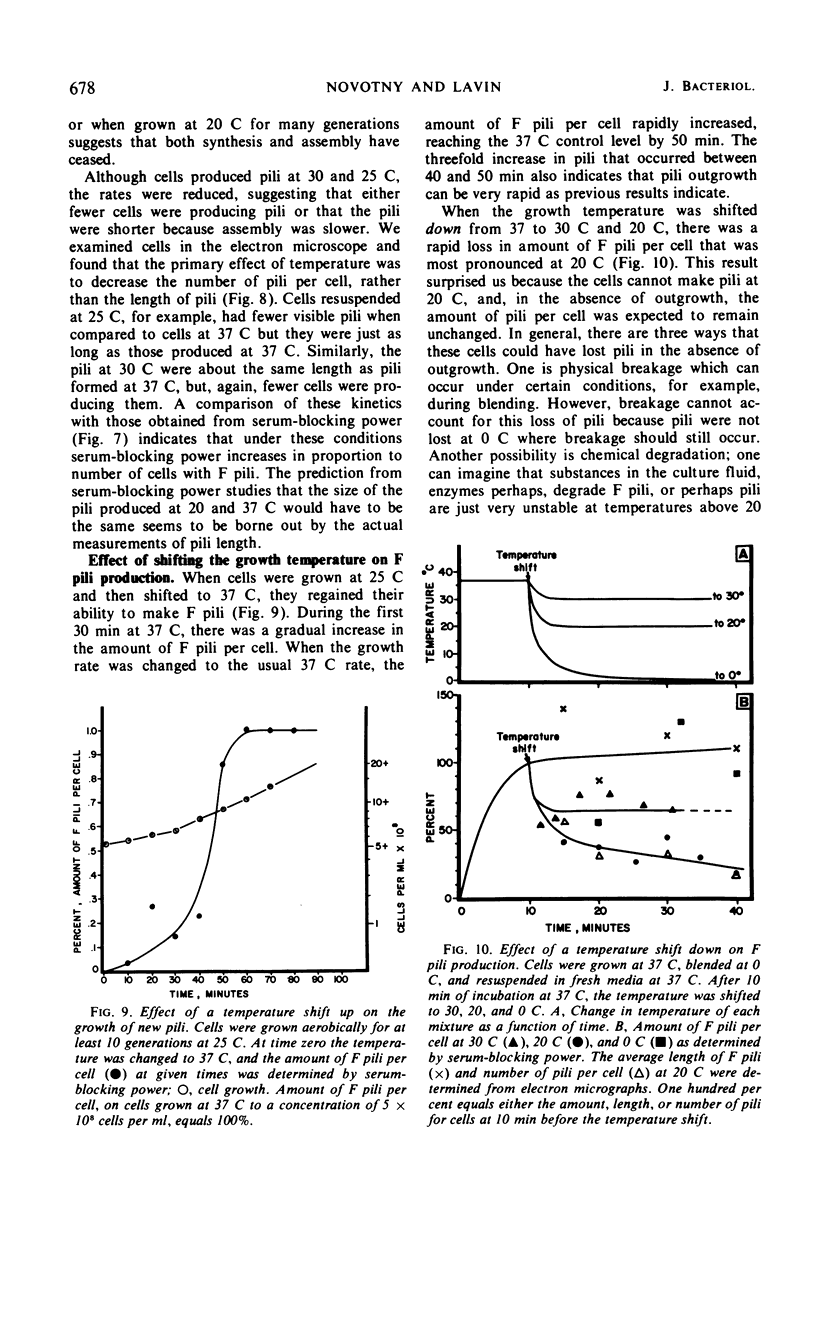
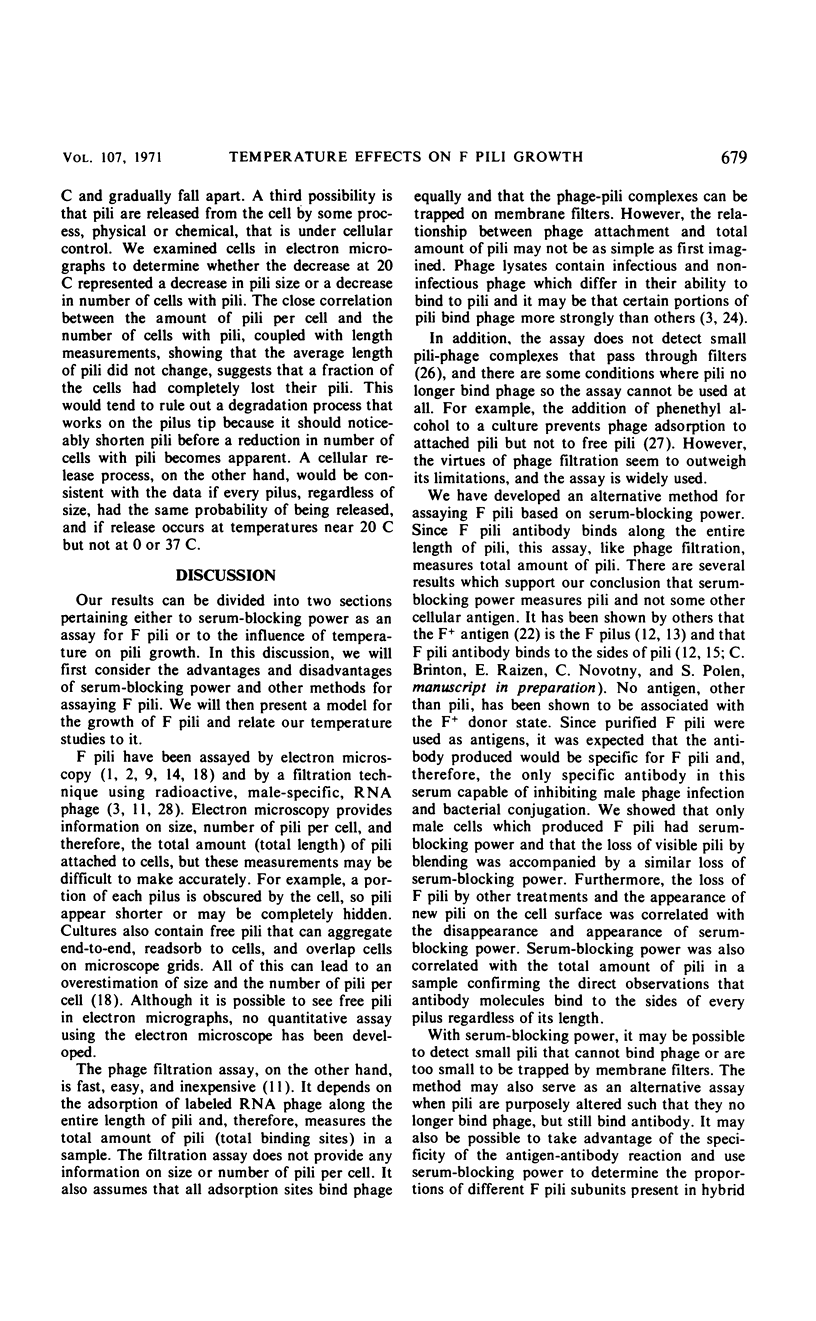
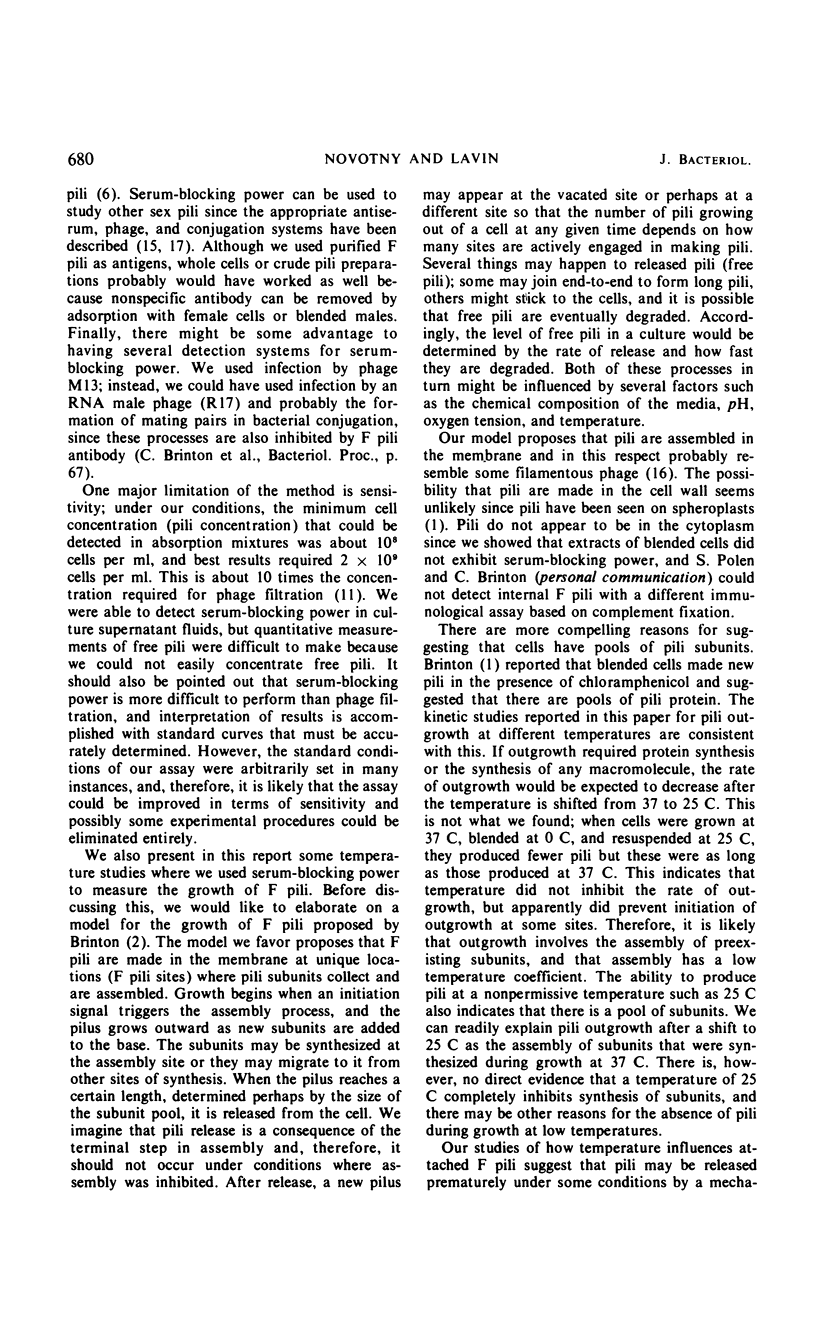
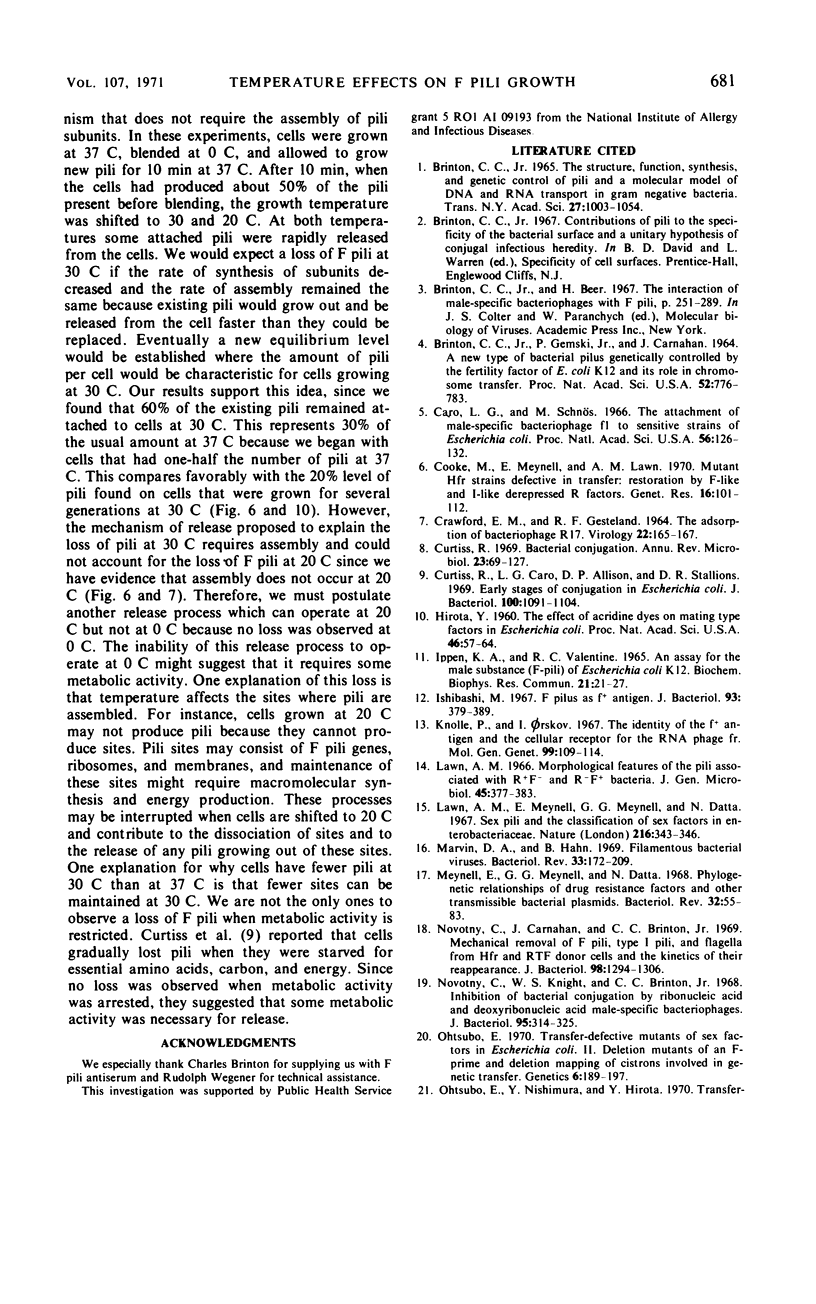
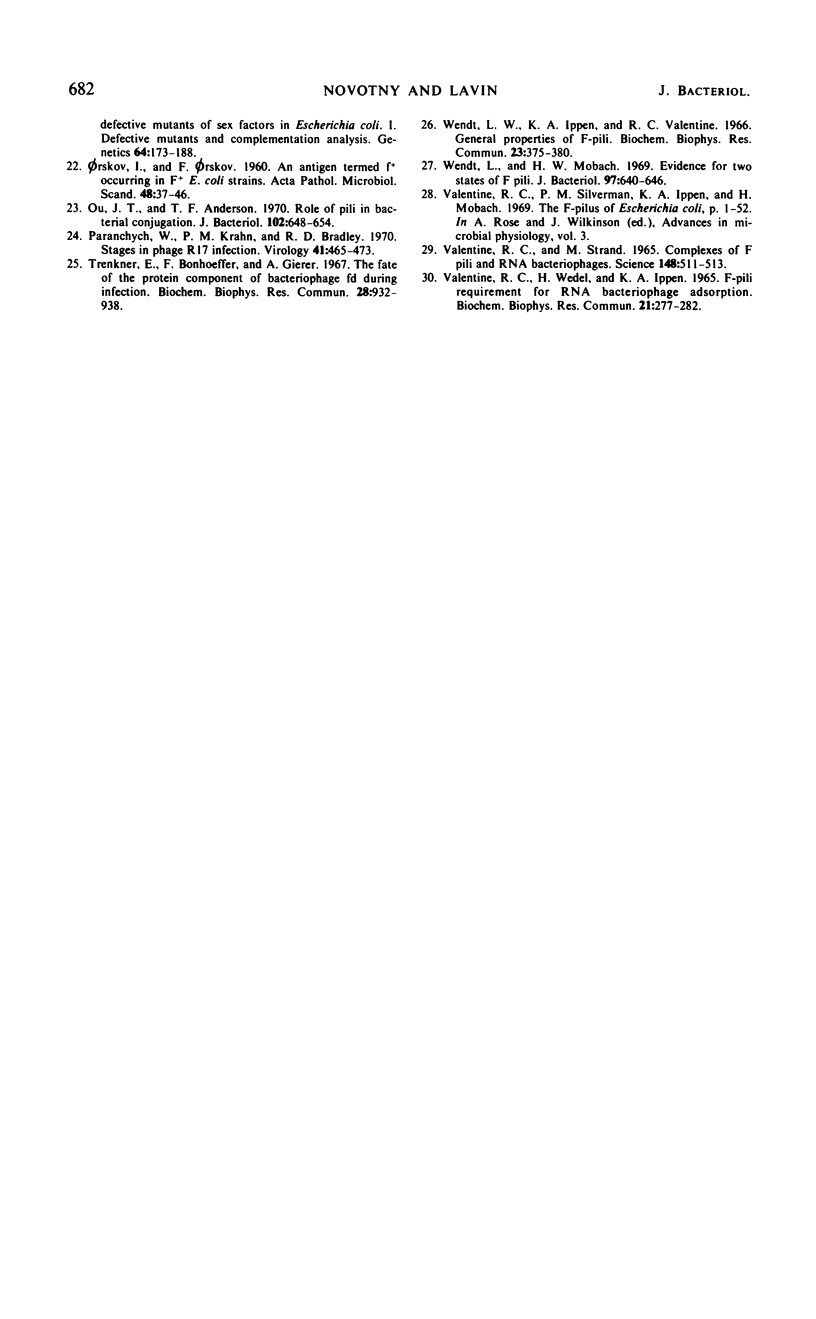
Selected References
These references are in PubMed. This may not be the complete list of references from this article.
- BRINTON C. C., Jr, GEMSKI P., Jr, CARNAHAN J. A NEW TYPE OF BACTERIAL PILUS GENETICALLY CONTROLLED BY THE FERTILITY FACTOR OF E. COLI K 12 AND ITS ROLE IN CHROMOSOME TRANSFER. Proc Natl Acad Sci U S A. 1964 Sep;52:776–783. doi: 10.1073/pnas.52.3.776. [DOI] [PMC free article] [PubMed] [Google Scholar]
- Brinton C. C., Jr The structure, function, synthesis and genetic control of bacterial pili and a molecular model for DNA and RNA transport in gram negative bacteria. Trans N Y Acad Sci. 1965 Jun;27(8):1003–1054. doi: 10.1111/j.2164-0947.1965.tb02342.x. [DOI] [PubMed] [Google Scholar]
- Caro L. G., Schnös M. The attachment of the male-specific bacteriophage F1 to sensitive strains of Escherichia coli. Proc Natl Acad Sci U S A. 1966 Jul;56(1):126–132. doi: 10.1073/pnas.56.1.126. [DOI] [PMC free article] [PubMed] [Google Scholar]
- Cooke M., Meynell E., Lawn A. M. Mutant Hfr strains defective in transfer: restoration by F-like and I-like de-repressed R factors. Genet Res. 1970 Aug;16(1):101–112. doi: 10.1017/s0016672300002317. [DOI] [PubMed] [Google Scholar]
- Curtiss R., 3rd Bacterial conjugation. Annu Rev Microbiol. 1969;23:69–136. doi: 10.1146/annurev.mi.23.100169.000441. [DOI] [PubMed] [Google Scholar]
- Curtiss R., 3rd, Caro L. G., Allison D. P., Stallions D. R. Early stages of conjugation in Escherichia coli. J Bacteriol. 1969 Nov;100(2):1091–1104. doi: 10.1128/jb.100.2.1091-1104.1969. [DOI] [PMC free article] [PubMed] [Google Scholar]
- Hirota Y. THE EFFECT OF ACRIDINE DYES ON MATING TYPE FACTORS IN ESCHERICHIA COLI. Proc Natl Acad Sci U S A. 1960 Jan;46(1):57–64. doi: 10.1073/pnas.46.1.57. [DOI] [PMC free article] [PubMed] [Google Scholar]
- Ippen K. A., Valentine R. C. An assay for the male substance (F-pili) of Escherichia coli K-12. Biochem Biophys Res Commun. 1965 Oct 8;21(1):21–27. doi: 10.1016/0006-291x(65)90420-1. [DOI] [PubMed] [Google Scholar]
- Ishibashi M. F pilus as f+ antigen. J Bacteriol. 1967 Jan;93(1):379–389. doi: 10.1002/path.1700930144. [DOI] [PMC free article] [PubMed] [Google Scholar]
- Knolle P., Orskov I. The identity of the f+ antigen and the cellular receptor for the RNA phage fr. Mol Gen Genet. 1967;99(1):109–114. doi: 10.1007/BF00306463. [DOI] [PubMed] [Google Scholar]
- Lawn A. M., Meynell G. G., Meynell E., Datta N. Sex pili and the classification of sex factors in the enterobacteriaceae. Nature. 1967 Oct 28;216(5113):343–346. doi: 10.1038/216343a0. [DOI] [PubMed] [Google Scholar]
- Lawn A. M. Morphological features of the pili associated with Escherichia coli K 12 carrying R factors or the F factor. J Gen Microbiol. 1966 Nov;45(2):377–383. doi: 10.1099/00221287-45-2-377. [DOI] [PubMed] [Google Scholar]
- Marvin D. A., Hohn B. Filamentous bacterial viruses. Bacteriol Rev. 1969 Jun;33(2):172–209. doi: 10.1128/br.33.2.172-209.1969. [DOI] [PMC free article] [PubMed] [Google Scholar]
- Meynell E., Meynell G. G., Datta N. Phylogenetic relationships of drug-resistance factors and other transmissible bacterial plasmids. Bacteriol Rev. 1968 Mar;32(1):55–83. doi: 10.1128/br.32.1.55-83.1968. [DOI] [PMC free article] [PubMed] [Google Scholar]
- Novotny C., Carnahan J., Brinton C. C., Jr Mechanical removal of F pili, type I pili, and flagella from Hfr and RTF donor cells and the kinetics of their reappearance. J Bacteriol. 1969 Jun;98(3):1294–1306. doi: 10.1128/jb.98.3.1294-1306.1969. [DOI] [PMC free article] [PubMed] [Google Scholar]
- Novotny C., Knight W. S., Brinton C. C., Jr Inhibition of bacterial conjugation by ribonucleic acid and deoxyribonucleic acid male-specific bacteriophages. J Bacteriol. 1968 Feb;95(2):314–326. doi: 10.1128/jb.95.2.314-326.1968. [DOI] [PMC free article] [PubMed] [Google Scholar]
- ORSKOV I., ORSKOV F. An antigen termed f-plus occurring in F-plus E. coli strains. Acta Pathol Microbiol Scand. 1960;48:37–46. [PubMed] [Google Scholar]
- Otsubo E. Transfer-defective mutants of sex factors in Escherichia coli. II. Deletion mutants of an F-prime and deletion mapping of cistrons involved in genetic transfer. Genetics. 1970 Feb;64(2):189–197. doi: 10.1093/genetics/64.2.189. [DOI] [PMC free article] [PubMed] [Google Scholar]
- Ou J. T., Anderson T. F. Role of pili in bacterial conjugation. J Bacteriol. 1970 Jun;102(3):648–654. doi: 10.1128/jb.102.3.648-654.1970. [DOI] [PMC free article] [PubMed] [Google Scholar]
- Paranchych W., Krahn P. M., Bradley R. D. Stages in phage R17 infection. Virology. 1970 Jul;41(3):465–473. doi: 10.1016/0042-6822(70)90168-6. [DOI] [PubMed] [Google Scholar]
- Trenkner E., Bonhoeffer F., Gierer A. The fate of the protein component of bacteriophage fd during infection. Biochem Biophys Res Commun. 1967 Sep 27;28(6):932–939. doi: 10.1016/0006-291x(67)90069-1. [DOI] [PubMed] [Google Scholar]
- VALENTINE R. C., STRAND M. COMPLEXES OF F-PILI AND RNA BACTERIOPHAGE. Science. 1965 Apr 23;148(3669):511–513. doi: 10.1126/science.148.3669.511. [DOI] [PubMed] [Google Scholar]
- Valentine R. C., Wedel H., Ippen K. A. F-pili requirement for RNA bacteriophage adsorption. Biochem Biophys Res Commun. 1965 Nov 22;21(4):277–282. doi: 10.1016/0006-291x(65)90189-0. [DOI] [PubMed] [Google Scholar]
- Wendt L. W., Ippen K. A., Valentine R. General properties of F-pili. Biochem Biophys Res Commun. 1966 May 25;23(4):375–380. doi: 10.1016/0006-291x(66)90736-4. [DOI] [PubMed] [Google Scholar]
- Wendt L., Mobach H. W. Evidence for two states of F pili. J Bacteriol. 1969 Feb;97(2):640–646. doi: 10.1128/jb.97.2.640-646.1969. [DOI] [PMC free article] [PubMed] [Google Scholar]


